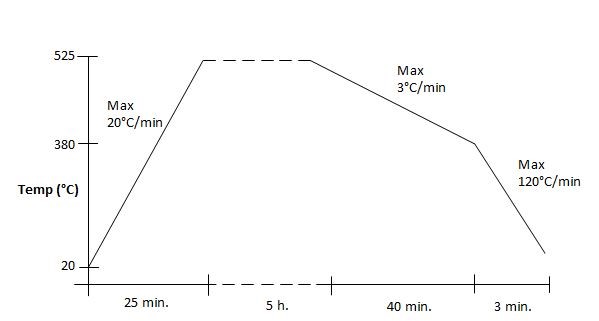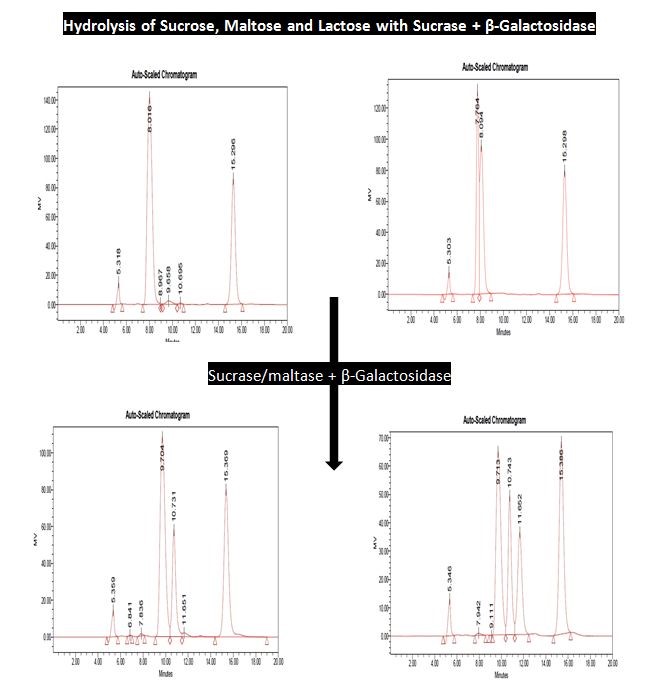综合总膳食纤维检测试剂盒
英文名:Integrated Total Dietary Fiber Assay Kit
货号:K-INTDF
规格:100 assays per kit
产品名称:综合总膳食纤维检测试剂盒
英文名称: Inegrated Total Dietary Fibre Assay Kit
型号规格:100次
品牌:爱尔兰Megaeyme公司
比重〜1.8
在水中的溶解度:易溶
pH值:7.0
气味:无
状态:液体
保质期:十年或以上(冰箱内)
成分
三玻璃瓶
名称 CAS
a-淀粉酶(胰)酶9014-71-5 1瓶(玻璃)
淀粉葡萄糖苷酶酶9032-08-0 1瓶(玻璃)
蛋白酶9014-01-1 1瓶(玻璃)
1. 简介:
膳食纤维是一种混合的复杂的有机物质,包括
亲水性化合物,如可溶性和不溶性多糖
和非消化寡糖以及一系列非
膨胀,或多或少疏水性化合物,如cutins ,
suberins和木质素。
膳食纤维是指碳水化合物及其相类似物质的总和,包括多糖、寡糖、木质素
以及相关的植物物质。 主要有纤维素、 半纤维素、 果胶及亲水胶体物质, 如树胶、
海藻多糖等组分;另外还包括植物细胞壁中所含有的木质素;不被人体消化酶所
分解的物质,如抗性淀粉、抗性糊精、抗性低聚糖、改性纤维素、黏质、寡糖以
及少量相关成分, 如蜡纸、 角质、 软木脂等。 总膳食纤维检测试剂盒是根据AOAC
991.43,AOAC 985.29,AACC32-07和AACC 32-05方法开发的,也适用于其它方
法,如AACC Method 32-21,AACC method32-06。
2. 检测原理
总膳食纤维(华盈)确定重复样品干
和脱脂(如脂肪含量是“ 10 % )的材料。样品在熟食
〜 100 ℃的热稳定α -淀粉酶,使gelatinisation ,水解
和depolymerisation的淀粉;孵育在60 ℃与蛋白酶(以
solubilise和depolymerise蛋白质)和淀粉葡萄糖苷酶(以
水解淀粉碎片葡萄糖) ;和治疗四卷
乙醇沉淀可溶性纤维和删除depolymerised
蛋白质和葡萄糖(淀粉) 。残渣过滤;洗
78 %乙醇, 95 %的乙醇和丙酮;干;和权衡。一个
重复分析蛋白质和其他的孵育在525摄氏度
确定灰。在华盈是重量过滤,干燥
残留物的重量少的蛋白质和灰烬。
主要利用Megazyme华盈试剂盒是,它包含
高纯度酶缺乏干预活动,活动
酵素是标准化。标准化的重要性
α -淀粉酶活性的测定抗性淀粉是良好
认可。 Megazyme淀粉葡萄糖苷酶基本上没有
纤维素酶,而其他常用的准备工作包含
重大污染这一活动,从而导致
solubilisation和低估了β -葡聚糖。所有Megazyme华盈
酶提供一个随时可以使用的,稳定,液态形式。
范围:
适用于谷物,水果和蔬菜,谷物和水果
产品和食品。
酶的纯度和标准化:
的有效性和纯洁性Megazyme α -淀粉酶,蛋白酶和
淀粉葡萄糖苷酶已经评价的标准
建议AOAC方法985.29和991.43 ,和油菜
方法32-05 。 Megazyme耐高温α -淀粉酶(电子BLAAM )有一个
活动3000 U / ml的( Ceralpha方法) ;蛋白酶是提供在
1concentration为50毫克/毫升( 〜 350酪氨酸单位/毫升) ;和
淀粉葡萄糖苷酶提供的浓度为200 U / ml的
(硝基苯β – maltoside基板) (或3300 U / ml的可溶性
淀粉) 。这种淀粉葡萄糖苷酶的活动是150 %的浓度
传统上用于华盈化验,以便0.2毫升(而不是0.3毫升)是
用于试验。
Megazyme淀粉葡萄糖苷酶(电子AMGDF )基本上是缺乏
纤维素酶,而在其他准备用于华盈决心,
纤维素酶污染可高达1 %
淀粉葡萄糖苷酶(对一项活动的基础上) 。这种程度的污染
导致低估的β -葡聚糖高达10-15 % 。
方法用于测量和标准化的Megazyme
酶,可以要求。
脱脂(如大于10%)干燥后的样品经热稳定a-淀粉酶、蛋白酶和淀粉葡萄糖
苷酶酶解消化, 酶解液通过乙醇沉淀、 过滤, 乙醇和丙酮洗涤残渣后干燥、 称重,
得到总膳食纤维(TDF)残渣;酶解液通过直接过滤、热水洗涤残渣,干燥后称
重,得到不溶性膳食纤维(IDF)残渣;滤液用乙醇沉淀,过滤、干燥、称重,
得到可溶性膳食纤维(SDF)残渣。TDF、IDF和SDF的残渣扣除蛋白质、灰分
和空白即得TDF、IDF和SDF含量。
Megazyme试剂盒的主要优势在于直接提供高纯度的酶,酶的活力是标准化
的,而标准化的a-淀粉酶的活力在测量抗性淀粉是公认的。Megazyme的淀粉葡
萄糖苷酶中基本没有纤维素酶,而其他常用的酶制剂中常含有这种污染物,这将
导致溶解和低估β-葡聚糖。Megazyme试剂盒提供的酶都是稳定的液体,可以保
存到试剂盒有效期,并且是直接应用液,不需要使用前再溶解。
3. 用途
适用于检测谷物、水果、蔬菜和加工食品中的总膳食纤维(TDF) 、不溶性
膳食纤维(IDF)和可溶性膳食纤维(SDF)的检测。
The Integrated Total Dietary Fiber test kit is suitable for the measurement and analysis of Integrated Total Dietary Fiber.
Updated to include resistant, branched maltodextrins as a component in dietary fiber.
K-INTDF- An Integrated Procedure (AOAC Method 2009.01 & 2011.25) for the measurement of Total Dietary Fiber (including resistant starch and non-digestible oligosaccharides). This method combines the key attributes of AOAC Official Methods of Analysis 2002.02, 985.29, 991.43, 2001.03.
Specific dietary fiber fractions are measured as follows:
1. Insoluble dietary fiber (IDF), Higher Molecular Weight Soluble Dietary Fiber (SDFP) and Lower Molecular Weight Soluble Dietary Fiber (SDFS) determination (AOAC Method 2011.25)
2. Total High Molecular Weight Dietary Fiber (HMWDF) and SDFS determination (AOAC Method 2009.01)
The enzymes used in these methods are of very high purity; they are effectively devoid of contaminating enzymes active on β-glucan, pectin and arabinoxylan.
Data calculators are located in the Technical Resources tab.
For the determination of Total Dietary Fiber in cereal products, foodstuffs, feeds and other materials. CODEX Type I method (2011)
Principle:
(Pancreatic α-amylase + amyloglucosidase)
(1) Non-resistant starch + H2O → D-glucose
(protease)
(2) Protein + H2O → peptides
(3) IDF (including resistant starch) and alcohol precipitated
soluble DF (SDFP) determined gravimetrically
(4) Alcohol soluble DF (SDFS) determined by HPLC
(5) Ash and residual protein determined on DF residues
and subtracted
Kit size: 100 assays
Method: Hydrolysis / removal of non-dietary
fibre components
Total assay time: ~ 3 hr work (over 2 days)
Detection limit: 0.5-100% of sample weight
Application examples:
Food ingredients, food products and other materials
Method recognition:
AOAC (Methods 2009.01 and 2011.25), AACC (Method 32-45.01 and
32-50.01) and CODEX (Type I method)
Advantages
- The only method that is consistent with the CODEX Alimentarius definition of dietary fibre
- High purity / standardised enzymes employed
- All reagents stable for > 2 years
- Mega-Calc™ software tool is available from our website for hassle-free raw data processing
- Very competitive price (cost per test)
Q1. There is an issue with the performance of the kit; the results are not as expected.
If you suspect that the Megazyme test kit is not performing as expected such that expected results are not obtained please do the following:
- Ensure that you have tested the standard sample that is supplied with the Megazyme test kit.
- Send the results of the kit standard, blank samples and the results obtained for your sample, in the relevant MegaCalc spreadsheet (if available) to Megazyme (cs@megazyme.com). Where available the relevant MegaCalc spreadsheet can be downloaded from where the product appears on the Megazyme website.
- State the kit lot number being used (this is found on the outside of the kit box).
- State which assay format was used (refer to the relevant page in the kit booklet if necessary).
- State exact details of any modifications to the standard procedure that is provided by Megazyme.
- State the sample type and describe the sample preparation steps if applicable.
Q2. Should the pH of the sample be adjusted even for samples in acidic media?
The pH of the assay solution after the sample is added should be the same as that of the assay buffer that is supplied with the kit.
Low sample volumes (e.g. 0.1 mL) are not likely to affect the pH of the assay solution and therefore may not require pH adjustment.
Samples above 0.1 mL are more likely to affect the pH of the assay solution and therefore the pH of these samples should be adjusted as described in the data booklet, prior to addition to the assay.
Q3. Is there a preferred rate of heating and cooling for the recommended crucible (Corning® No. 32940-50C or equivalent) to avoid breakages?
The crucible has the potential to break if heated or cooled too rapidly. The graph below shows the manufacturer’s recommended heating and cooling profile forsafe use with the crucible.

Application Note:
Removal of Sucrose, Maltose and Fructose from F3
SUCRASE (MALTASE) + β-GALACTOSIDASE (Lot 111101)
E-SUCRBG
Sucrase (170 U), α-glucosidase (2600 U) and β-galactosidase (3000 U); freeze dried.
For use in the removal of sucrose, maltose and lactose in dietary fibre determinations. In the Integrated Total Dietary Fibre procedure, in HPLC analysis of non-digestible oligosaccharides using the Waters Sugar-Pak column, the fructosyl-trisaccharide β-D-Fruf-(2→1)-β-D-Fruf-(2→1)-β-D-Fruf, chromatographs at a similar point to the disaccharides, sucrose, maltose and lactose. Accurate determination of this trisaccharide requires the hydrolysis of these disaccharides. This can be achieved using this enzyme mixture.
PROPERTIES
1. ELECTROPHORETIC PURITY:
This is a mixture of sucrase (maltase; from Bacillus stearothermophilis):
– Single major band on SDS-gel electrophoresis (57,750) plus β-galactosidase (from A. niger)
– Single band on isoelectric focusing
2. ACTIVITY:
This enzyme mixture gives complete hydrolysis of sucrose, maltose and lactose under the defined assay conditions, with no hydrolysis of the trisaccharide, β-D-Fruf-(2→1)-β-D-Fruf-(2→1)-β-D-Fruf.
3. STORAGE CONDITIONS:
The enzyme is supplied as a lyophilised powder and should be stored at -20˚C. On dissolution in buffer or water, the enzyme should be stored in the frozen state. It is recommended that all buffers used for dilution contain BSA (0.5 mg/mL).
4. PREPARATION OF ENZYME FOR USE:
Dissolve the contents of one vial in 6 mL of 5 mM sodium acetate buffer (pH 5.0). Transfer aliquots of approx. 2 mL to polypropylene tubes and store at -20˚C between use. Can be thawed and re-frozen several times.
INCUBATION CONDITIONS:
To 1 mL of sugar mixture obtained in the Integrated Total Dietary Fibre procedure [Step I(b)] containing up to 5 mg/mL of sucrose, maltose and/or lactose and fructotriose,
add:
0.1 mL of sucrase/β-galactosidase enzyme mixture, and incubate at 40˚C, for 60 min. Terminate the reaction by incubating the tube at 100˚C for 2 min and centrifuge the suspension in a Microfuge at 12,000 rpm for 5 min.
SAMPLE PREPARATION AND HPLC:
Analyse the supernatant solution by HPLC using a Waters Sugar-Pak® column as described in the Megazyme kit data booklet for the Integrated Total Dietary Fibre method (K-INTDF). Calculate the amount of fructo-triose by reference to the D-sorbitol internal standard. This amount should then be added to the determined amount of non-digestible oligosaccharides [NDO; low molecular weight soluble dietary fibre; Soluble Dietary Fibre soluble in 78% aqueous ethanol (SDFS)].

Q4. How should I prepare the required 78% ethanol solution?
A volume reduction occurs on mixing water with 95% ethanol (or IMS). 1 L of 78% ethanol is prepared by adding 821 mL 95% ethanol (or IMS) to 207 mL H2O.
If using a 1 L volumetric flask, this is best accomplished by placing 821 mL 95% ethanol (or IMS) into the volumetric flask. Dilute to volume with deionised water. Mix well. Check the level and if necessary add more deionised water to bring it back up to the 1 L mark.
